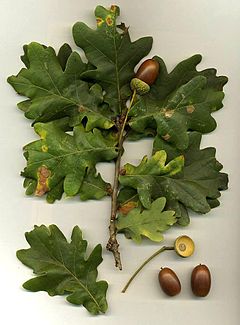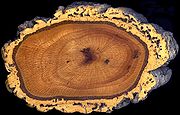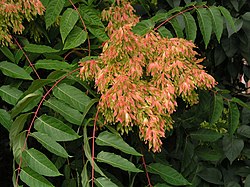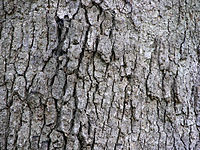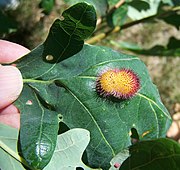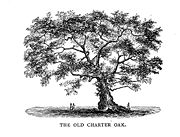Ailanthus altissima
Ailanthus altissima (pronounced /eɪˈlænθəs ælˈtɪsɪmə/), commonly known as tree of heaven, ailanthus, or in Chinese as chouchun (Chinese: 臭椿; pinyin: chòuchūn), is a deciduous tree in the quassia family (Simaroubaceae). It is native to northeast and central China as well as Taiwan. Unlike other members of the genus Ailanthus, it is found in temperate climates rather than the tropics. The tree grows rapidly and is capable of reaching heights of 15 metres (50 ft) in 25 years. However, the species is also short lived and rarely lives more than 50 years. Other common names include China sumac, copal tree, stink tree and ghetto palm.
A. altissima was first brought from China to Europe in the 1740s and to the United States in 1784. It was one of the first trees brought west during a time when chinoiserie was dominating European arts, and was initially hailed as a beautiful garden specimen. However, enthusiasm soon waned after gardeners became familiar with its suckering habits and its offensive odour. Despite this, it was used extensively as a street tree during much of the 19th century. Outside of Europe and the United States, the plant has been spread to many other areas beyond its native range. In a number of these, it has become an invasive species due to its ability to quickly colonise disturbed areas and suppress competition with allelopathic chemicals. It is considered a noxious weed in Australia, the United States, New Zealand and several countries in southern and eastern Europe. The tree also re-sprouts vigorously when cut, making its eradication extremely difficult and time consuming.
In China, the tree of heaven has a long and rich history. It was mentioned in the oldest extant Chinese dictionary and listed in countless Chinese medical texts for its purported ability to cure ailments ranging from mental illness to balding. The roots, leaves and bark are still used today in traditional Chinese medicine, primarily as an astringent. The tree has been grown extensively both in China and abroad as a host plant for the ailanthus silkmoth, a moth involved in silk production. Ailanthus has become a part of western culture as well, with the tree serving as the central metaphor and subject matter of the best-selling American novel A Tree Grows in Brooklyn by Betty Smith.
Description

Botanical drawing of the leaves, flowers and samaras from
Britton and
Brown's 1913
Illustrated flora of the northern states and Canada A. altissima is a medium-sized tree that reaches heights between 17 and 27 metres (56 and 90 ft) with a diameter at breast height of about 1 metre (40 in).The bark is smooth and light grey, often becoming somewhat rougher with light tan fissures as the tree ages. The twigs are stout, smooth to lightly pubescent, and reddish or chestnut in colour. They have lenticels as well as heart-shaped leaf scars (i.e. a scar left on the twig after a leaf falls) with many bundle scars (i.e. small marks where the veins of the leaf once connected to the tree) around the edges. The buds are finely pubescent, dome shaped, and partially hidden behind the petiole, though they are completely visible in the dormant season at the sinuses of the leaf scars. The branches are light to dark gray in colour, smooth, lustrous, and containing raised lenticels that become fissures with age. The ends of the branches become pendulous. All parts of the plant have a distinguishing strong odour that is often likened to rotting peanuts or cashews.
The leaves are large, odd- or even-pinnately compound, and arranged alternately on the stem. They range in size from 30 to 90 cm (1 to 3 ft) in length and contain 10-41 leaflets organised in pairs, with the largest leaves found on vigorous young sprouts. The rachis is light to reddish-green with a swollen base. The leaflets are ovate-lanceolate with entire margins, somewhat asymmetric and occasionally not directly opposite to each others. Each leaflet is 5 to 18 cm (2 to 7 inches) long and 2.5 to 5 cm (1 to 2 inches) wide. They have a long tapering end while the bases have two to four teeth, each containing one or more glands at the tip. The leaflets' upper sides are dark green in colour with light green veins, while the undersides are a more whitish green. The petioles are 5 to 12 mm (0.2 to 0.5 inches) long. The lobed bases and glands distinguish it from similar sumac species.
 |
|  |
| Bark and flowers of A. altissima |
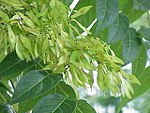
Immature seeds on a female tree.
The flowers are small and appear in large panicles up to 50 cm (20 inches) in length at the end of new shoots. The individual flowers are yellowish green to reddish in colour, each with five petals and sepals The sepals are cup-shaped, lobed and united while the petals are valvate (i.e. they meet at the edges without overlapping), white and hairy towards the inside. They appear from mid-April in the south of its range to July in the north. A. altissima is dioecious, with male and female flowers being borne on different individuals. Male trees produce three to four times as many flowers as the females, making the male flowers more conspicuous. Furthermore, the male plants emit a foul smelling odour while flowering to attract pollinating insects. Female flowers contain ten (or rarely five through abortion) sterile stamens (stamenoides) with heart-shaped anthers. The pistil is made up of five free carpels (i.e. they are not fused), each containing a single ovule. Their styles are united and slender with star-shaped stigmas. The male flowers are similar in appearance, but they of course lack a pistil and the stamens do function, each being topped with a globular anther and a glandular green disc. The seeds borne on the female trees are 5 mm in diameter and each is encapsulated in a samara that is 2.5 cm long (1 inch) and 1 cm broad, appearing July though August, but usually persisting on the tree until the next spring. The samara is twisted at the tips, making it spin as it falls and assisting wind dispersal. The females can produce huge amounts of seeds, normally around 30,000 per kilogram of tree.
Taxonomy
The first scientific descriptions of the tree of heaven were made shortly after it was introduced to Europe by the French Jesuit Pierre Nicholas d'Incarville. d'Incarville had sent seeds from Peking via Siberia to his botanist friend Bernard de Jussieu in the 1740s. The seeds sent by d'Incarville were thought to be from the economically important and similar looking Chinese varnish tree (Toxicodendron vernicifluum), which he had observed in the lower Yangtze region, rather than the tree of heaven. d'Incarville attached a note indicating this, which caused much taxonomic confusion over the next few decades. In 1751, Jussieu planted a few seeds in France and sent others on to Philip Miller, the superintendent at the Chelsea Physic Garden, and to Philip C. Webb, the owner of an exotic plant garden in Busbridge, England.
Confusion in naming began when the tree was described by all three men with three different names. In Paris, Linnaeus gave the plant the name Rhus succedanea, while it was known commonly as grand vernis du Japon. In London the specimens were named by Miller as Toxicodendron altissima and in Busbridge it was dubbed in the old classification system as Rhus Sinese foliis alatis. There are extant records from the 1750s of disputes over the proper name between Philip Miller and John Ellis, curator of Webb's garden in Busbridge. Rather than the issue being resolved, more names soon appeared for the plant: Jakob Friedrich Ehrhart observed a specimen in Utrecht in 1782 and named it Rhus cacodendron.
Light was shed on the taxonomic status of ailanthus in 1788 when René Louiche Desfontaines observed the samaras of the Paris specimens, which were still labelled Rhus succedanea, and came to the conclusion that the plant was not a sumac. He published an article with an illustrated description and gave it the name Ailanthus glandulosa, placing it in the same genus as the tropical species then known as A. integrifolia (white siris, now A. triphysa). The name is derived from the Ambonese word ailanto, meaning "heaven-tree" or "tree reaching for the sky". The specific glandulosa , referring to the glands on the leaves, persisted until as late as 1957, but it was ultimately made invalid as a later homonym at the species level.The current species name comes from Walter T. Swingle who was employed by the United States Department of Plant Industry. He decided to transfer Miller's older specific name into the genus of Desfontaines, resulting in the accepted name Ailanthus altissima. Altissima is Latin for "very tall", and refers to the sizes the tree can reach. The plant is sometimes incorrectly cited with the specific epithet in the masculine (glandulosus or altissimus), which is incorrect since botanical, like Classical Latin, treats most tree names as feminine.
There are three varieties of A. altissima:
- A. altissima var. altissima, which is the type variety and is native to mainland China.
- A. altissima var. tanakai, which is endemic to northern Taiwan highlands. It differs from the type in having yellowish bark, odd-pinnate leaves that are also shorter on average at 45 to 60 cm long with only 13-25 scythe-like leaflets. is listed as endangered in the IUCN Red List of threatened species due to loss of habitat for building and industrial plantations.
- A. altissima var. sutchuenensis, which differs in having red branchlets.
Distribution and habitat
A. altissima is native to northern and central China, Taiwan[13] and northern Korea.[14] In Taiwan it is present as var. takanai.[12] In China it is native to every province except Gansu, Heilongjiang, Hainan, Jilin, Ningxia, Qinghai, Xinjiang, and Tibet.
The tree prefers moist and loamy soils, but is adaptable to a very wide range of soil conditions and pH values. It is drought-hardy, but not tolerant of flooding. It also does not tolerate deep shade.In China it is often found in limestone-rich areas. The tree of heaven is found within a wide range of climatic conditions.In its native range it is found at high altitudes in Taiwan as well as lower ones in mainland China. In the U.S. it is found in arid regions bordering the Great Plains, very wet regions in the southern Appalachians, and cold areas of the lower Rocky Mountains. Prolonged cold and snow cover cause dieback, though the trees re-sprout from the roots.
As an exotic plant
The earliest introductions of A. altissima to countries outside of its native range were to the southern areas of Korea as well as to Japan. It is possible that the tree is native to these areas, but it is generally agreed that the tree was a very early introduction.Within China itself it has also been naturalised beyond its native range in areas such as Qinghai, Ningxia and Xinjiang.
In 1784, not long after Jussieu had sent seeds to England, some were forwarded to the United States by William Hamilton, a gardener in Philadelphia. In both Europe and America it quickly became a favoured ornamental, especially as a street tree, and by 1840 it was available in most nurseries. The tree was separately brought to California in the 1890s by Chinese immigrants who came during the California Gold Rush. It has escaped cultivation in all areas where it was introduced, but most extensively in the United States. It has naturalised across much of Europe, including Germany, Austria, Switzerland, the Pannonian region (i.e. southeastern Europe from Italy and Hungary south to Bosnia and Herzegovina) and most countries of the Mediterranean Basin.Ailanthus has also been introduced to Argentina, Australia (where it is a declared weed in New South Wales and Victoria),New Zealand and several countries in the Middle East such as Pakistan.
In North America, A. altissima is present from Massachusetts in the east, west to southern Ontario, southwest to Iowa, south to Texas, and east to the north of Florida. On the west coast it is found from New Mexico west to California and north to Washington the east of its range it grows most extensively in disturbed areas of cities, where it was long ago present as a planted street tree. It also grows extensively along roads and railways. For example, a 2003 study in North Carolina found the tree of heaven was present on 1.7% of all highway and railroad edges in the state and had been expanding its range at the rate of 4.76% counties per year.Similarly, another study conducted in southwestern Virginia determined that the tree of heaven is thriving along approximately 30% of the state's interstate highway system length or mileageIt sometimes enters undisturbed areas as well and competes with native plants. In western North America it is most common in mountainous areas around old dwellings and abandoned mining operations.
Ecology
Ailanthus is an opportunistic plant that thrives in full sun and disturbed areas. It spreads aggressively both by seeds and vegetatively by root sprouts. It can re-sprout rapidly after being cut. It is considered a shade-intolerant tree and cannot compete in low-light situations, though it is sometimes found competing with hardwoods, but such competition rather indicates it was present at the time the stand was established. On the other hand, a study in an old-growth hemlock-hardwood forest in New York found that Ailanthus was capable of competing successfully with native trees in canopy gaps where only 2 to 15% of full sun was available. The same study characterised the tree as using a "gap-obligate" strategy in order to reach the forest canopy, meaning it grows rapidly during a very short period rather than growing slowly over a long period. It is a short lived tree in any location and rarely lives more than 50 years. is among the most pollution-tolerant of tree species, including to sulfur dioxide, which it absorbs in its leaves. It can withstand cement dust and fumes from coal tar operations, as well as resist ozone exposure relatively well. Furthermore, high concentrations of mercury have been found built up in tissues of the plant.
Ailanthus has been used to re-vegetate areas where acid mine drainage has occurred and it has been shown to tolerate pH levels as low as 4.1 (approximatively that of tomato juice). It can withstand very low phosphorus levels and high salinity levels. The drought-tolerance of the tree is strong due to its ability to effectively store water in its root system. It is frequently found in areas where few trees can survive. The roots are also aggressive enough to cause damage to subterranean sewers and pipes. Along highways it often forms dense thickets in which few other tree species are present, largely due to the toxins it produces to prevent competition.
Ailanthus produces an allelopathic chemical called ailanthone, which inhibits the growth of other plants.The inhibitors are strongest in the bark and roots, but are also present in the leaves, wood and seeds of the plant. One study showed that a crude extract of the root bark inhibited 50% of a sample of garden cress (Lepidium sativum) seeds from germinating. The same study tested the extract as an herbicide on garden cress, redroot pigweed (Amaranthus retroflexus), velvetleaf (Abutilon theophrastii), yellow bristlegrass (Setaria glauca), barnyard grass (Echinochloa crusgalli), pea (Pisum sativum cv. Sugar Snap) and maize (Zea mays cv. Silver Queen). It proved able to kill nearly 100% of seedlings with the exception of velvetleaf, which showed some resistance. Another experiment showed a water extract of the chemical was either lethal or highly damaging to 11 North American hardwoods and 34 conifers, with the white ash (Fraxinus americana) being the only plant not adversely affected. The chemical does not, however, affect the tree of heaven's own seedlings, indicating that A. altissima has a defence mechanism to prevent autotoxicity. in various plant species has been shown to increase with exposure. Populations without prior exposure to the chemicals are most susceptible to them. Seeds produced from exposed plants have also been shown to be more resistant than their unexposed counterparts.
The tree of heaven is a very rapidly growing tree, possibly the fastest growing tree in North America. Growth of one to two metres (3.3 to 6.6 ft) per year for the first four years is considered normal. Shade considerably hampers growth rates. Older trees, while growing much slower, still do so faster than other trees. Studies found that Californian trees grew faster than their East Coast counterparts, and American trees in general grew faster than Chinese ones.
In northern Europe the tree of heaven was not considered naturalised in cities until after the Second World War. This has been attributed to the tree's ability to colonise areas of rubble of destroyed buildings where most other plants would not grow. In addition, the warmer microclimate in cities offers a more suitable habitat than the surrounding rural areas. For example, one study in Germany found the tree of heaven growing in 92% of densely populated areas of Berlin, 25% of its suburbs and only 3% of areas outside the city altogether.In other areas of Europe this is not the case as climates are mild enough for the tree to flourish. It has colonised natural areas in Hungary, for example, and is considered a threat to biodiversity at that country's Aggtelek National Park.
Several species of Lepidoptera utilise the leaves of ailanthus as food, including the Indian moon moth (Actias selene) and the grass yellow (Eurema hecabe). In North America the tree is the host plant for the ailanthus webworm (Atteva punctella), though this ermine moth is native to Central and South America and originally used other members of the mostly tropical Simaroubaceae as its hosts.In its native range A. altissima is associated with at least 32 species of arthropods and 13 species of fungi.
Due to the tree of heaven's weedy habit, landowners and other organisations often resort to various methods of control in order to keep its populations in check. For example, the city of Basel in Switzerland has an eradication program for the tree. It can be very difficult to eradicate, however. Means of eradication can be physical, thermal, managerial, biological or chemical. A combination of these can be most effective, though they must of course be compatible. All have some positive and negative aspects, but the most effective regime is a mixture of chemical and physical control. This involves the application of foliar or basal herbicides in order to kill existing trees, while either hand pulling or mowing seedlings in order to prevent new growth.
Uses

A male ailanthus silkmoth from the
Texas A&M insect collection
In addition to its use as an ornamental plant, the tree of heaven is also used for its wood, medicinal properties, and as a host plant to feed silkworms of the moth Samia cynthia, which produces silk that is stronger and cheaper than mulberry silk, although with inferior gloss and texture. It is also unable to take dye. This type of silk is known as "pongee" or "Shantung silk", the second name being derived from the Shandong Province of China where this silk is often produced. Its production is particularly well known in the Yantai region of that province. The moth has also been introduced in the United States.
The pale yellow, close-grained and satiny wood of ailanthus has been used in cabinet work.It is flexible and well suited to the manufacture of kitchen steamers, which are important in Chinese cuisine for cooking mantou, pastries and rice. The Chekiang Province of eastern China is most famous for producing these steamers.It is also considered a good source of firewood across much of its range as it moderately hard and heavy, yet readily available. There are problems with using the wood as lumber, however. Because the trees exhibit rapid growth for the first few years, the trunk has uneven texture between the inner and outer wood, which can cause the wood to twist or crack during drying. Techniques have been developed for drying the wood so as to prevent this cracking, allowing it to be commercially harvested. Although the live tree tends to have very flexible wood, the wood is quite hard once properly dried.
Cultivation
Tree of heaven is a popular ornamental tree in China and valued for its tolerance of difficult growing conditions.It was once very popular in cultivation in both Europe and North America, but this popularity dropped, especially in the United States, due to the disagreeable odour of its blossoms and the weediness of its habit. The problem of odour was previously avoided by only selling pistillate plants since only males produce the smell, but a higher seed production also results. Michael Dirr, a noted American horticulturalist and professor at the University of Georgia, reported meeting, in 1982, a grower who could not find any buyers. He further writes (his emphasis):
For most landscaping conditions, it has no value as there are too many trees of superior quality; for impossible conditions this tree has a place; selection could be made for good habit, strong wood and better foliage which would make the tree more satisfactory; I once talked with an architect who tried to buy Ailanthus for use along polluted highways but could not find an adequate supply [...]
—Michael A. Dirr, Manual of Woody Landscape Plants
In Europe, however, the tree is still used in the garden to some degree as its habit is generally not as invasive as it is in America. In the United Kingdom it is especially common in London squares, streets, and parks, though it is also frequently found in gardens of southern England and East Anglia. It becomes rare in the north, occurring only seldomly in southern Scotland. It is also rare in Ireland.In Germany the tree is commonly planted in gardens. The tree has furthermore become unpopular in cultivation in the west due to the fact that it is short-lived and that the trunk soon becomes hollow, making trees more than two feet in diameter unstable in high winds.
A few cultivars exist, but they are not often sold outside of China and probably not at all in North America:
- ‘Hongye’ - The name is Chinese and means "red leaves". As the name implies it has attractive vivid red foliage
- ‘Thousand Leaders’
- ‘Metro’ - A male cultivar with a tighter crown than usual and a less weedy habit
- ‘Erythrocarpa’ - The fruits are a striking red
- ‘Pendulifolia’ - Leaves are much longer and hang elegantly
Medicinal
Nearly every part of A. altissima has some application in Chinese traditional medicine. One of the oldest recipes, recorded in a work from 732 AD, is used for treating mental illness. It involved chopped root material, young boys' urine and douchi. After sitting for a day the liquid was strained out and given to the patient over the course of several days.
Another source from 684 AD, during the Tang dynasty and recorded in Li Shizhen's Compendium of Materia Medica, states that when the leaves are taken internally, they make one incoherent and sleepy, while when used externally they can be effectively used to treat boils, abscesses and itches. Yet another recipe recorded by Li uses the leaves to treat baldness. This formula calls for young leaves of ailanthus, catalpa and peach tree to be crushed together and the resulting liquid applied to the scalp to stimulate hair growth.
The dried bark, however, is still an officinal drug and is listed in the modern Chinese materia medica as chun bai pi (Chinese: 椿白皮; pinyin: chūnbáipí), meaning "white bark of spring". Modern works treat it in detail, discussing chemical constituents, how to identify the product and its pharmaceutical uses. It is prepared by felling the tree in fall or spring, stripping the bark and then scraping off the hardest, outermost portion, which is then sun-dried, soaked in water, partially re-dried in a basket and finally cut into strips. The bark is said to have cooling and astringent properties and is primarily used to treat dysentery, intestinal hemorrhage, menorrhagia and spermatorrhea. It is only prescribed in amounts between 4 and 10 grams, so as not to poison the patients. Li's Compendium has 18 recipes that call for the bark. Asian and European chemists have found some justification for its medical use as it contains a long list of active chemicals that include quassin and saponin, while ailanthone, the allelopathic chemical in the tree of heaven, is a known antimalarial agent. is available in most shops dealing in Chinese traditional medicine A tincture of the root-bark has been used successfully in treating cardiac palpitation, asthma and epilepsy.
The samaras are also used in modern Chinese medicine under the name feng yan cao (simplified Chinese: 凤眼草; traditional Chinese: 鳳眼草; pinyin: fèngyǎncǎo), meaning "herbal phoenix eye". They are used as a hemostatic, spermatorrhea and for treating patients with blood in their feces or urine. It was clinically shown to be able to treat trichomoniasis, a vaginal infection caused by the protozoan Trichomonas vaginalis. In occident, an extract of the bark sold under the synonym A. glandulosa is sometimes used as an herbal remedy for various ailments including cancer.[41]
Anecdotal evidence suggests that the plant may be mildly toxic. The noxious odours have been associated with nausea and headaches, as well as with contact dermatitis reported in both humans and sheep, who also developed weakness and paralysis. It contains a quinone irritant, 2,6-dimethoxybenzoquinone, as well as active quassinoids which may account for these effects, but they have, however, proved difficult or impossible to reproduce in humans and goats. In one trial a tincture from the blossom and foliage caused nausea, vomiting and muscular relaxation.
Culture
In addition to the tree of heaven's various uses, it has also been a part of Chinese culture for many centuries and has more recently attained a similar status in the west. Within the oldest extant Chinese dictionary, the Erya, written in the 3rd century BC, the tree of heaven is mentioned second among a list of trees. It was mentioned again in a materia medica compiled during the Tang dynasty in 656 AD. Each work favoured a different character, however, and there is still some debate in the Chinese botanical community as to which character should be used. The current name, chouchun (Chinese: 臭椿; pinyin: chòuchūn), means "stinking spring", and is a relatively new appellation. People living near the lower Yellow River know it by the name chunshu (simplified Chinese: 椿树; traditional Chinese: 椿樹; pinyin: chūnshù), meaning "spring tree". The name stems from the fact that A. altissima is one of the last trees to come out of dormancy, and as such its leaves coming out would indicate that winter was truly over.

Cover of a 2006 reprint of Betty Smith's
A Tree Grows in Brooklyn with a drawing of ailanthus in the background
In Chinese literature, ailanthus is often used for two rather extreme metaphors, with a mature tree representing a father and a stump being a spoiled child. This manifests itself occasionally when expressing best wishes to a friend's father and mother in a letter, where one can write "wishing your ailanthus and daylily are strong and happy", with ailanthus metaphorically referring to the father and daylily to the mother. Furthermore, one can scold a child by calling him a "good-for-nothing ailanthus stump sprout", meaning the child is irresponsible. This derives from the literature of Zhuangzi, a Taoist philosopher, who referred to a tree that had developed from a sprout at the stump and was thus unsuitable for carpentry due to its irregular shape. Later scholars associated this tree with ailanthus and applied the metaphor to children who, like stump sprouts of the tree, will not develop into a worthwhile human being if they don't follow rules or traditions.
The 1943 book A Tree Grows in Brooklyn by Betty Smith uses the tree of heaven as its central metaphor, using it as an analogy for the ability to thrive in a difficult environment. At the time as well as now, ailanthus was common in neglected urban areas. She writes:
There's a tree that grows in Brooklyn. Some people call it the Tree of Heaven. No matter where its seed falls, it makes a tree which struggles to reach the sky. It grows in boarded up lots and out of neglected rubbish heaps. It grows up out of cellar gratings. It is the only tree that grows out of cement. It grows lushly...survives without sun, water, and seemingly earth. It would be considered beautiful except that there are too many of it.
—A Tree Grows in Brooklyn, Introduction
Ailanthus is also sometimes counter-nicknamed "tree from hell" due its prolific invasiveness and the difficulty in eradicating it. In cities, it often bears the name "ghetto palm" because of its propensity for growing in the infertile soils of urban areas, or on abandoned and poorly maintained properties. Ingo Vetter, a German artist and professor of fine arts at Umea University in Sweden, was influenced by the idea of the "ghetto palm" and installed a living ailanthus tree taken from Detroit for an international art show called Shrinking Cities at the KW Institute of Contemporary Art in Berlin in 2004.
